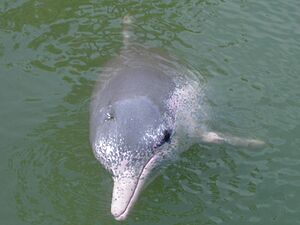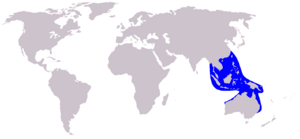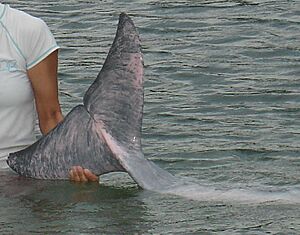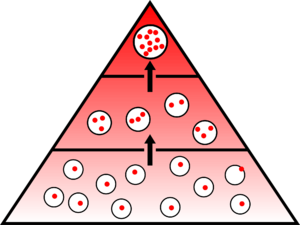Indo-Pacific humpback dolphin facts for kids
Quick facts for kids Indo-Pacific humpback dolphin |
|
|---|---|
 |
|
| At the theme aquarium in Pattaya, Thailand. | |
| Conservation status | |
| Scientific classification | |
| Genus: |
Sousa
|
| Species: |
chinensis
|
| Subspecies | |
|
|
 |
|
| Combined ranges of Sousa chinensis and Sousa sahulensis | |
The Indo-Pacific humpback dolphin (Sousa chinensis) is a special type of dolphin. It lives in the warm coastal waters of the eastern Indian Ocean and western Pacific Ocean. People in places like China and Hong Kong often call it the Chinese white dolphin.
Some scientists used to think this dolphin was just a type of Indian Ocean humpback dolphin. But DNA testing has shown they are actually different species. In 2014, another new species, the Australian humpback dolphin, was found and separated from the Indo-Pacific humpback dolphin.
Contents
Types of Humpback Dolphins
Scientists have found two main types, or subspecies, of the Indo-Pacific humpback dolphin:
- S. c. chinensis, also known as the Chinese humpback dolphin.
- S. c. taiwanensis, or the Taiwanese humpback dolphin.
What They Look Like
Adult Indo-Pacific humpback dolphins can be grey, white, or even pink! Some might look like they are albino (completely white). The pink color comes from many blood vessels under their skin, which help them stay cool in warm waters.
These dolphins are quite big. Adults are about 2 to 3.5 meters (6.5 to 11.5 feet) long and weigh 150 to 230 kilograms (330 to 500 pounds). They can live for up to 40 years!
When they are born, baby dolphins are dark grey or black and about 1 meter (3.3 feet) long. As they get older, their skin becomes lighter and more spotted.
How They Behave
Indo-Pacific humpback dolphins usually live in small groups of fewer than ten dolphins. They hunt for food together using echolocation. This is like using sound to "see" underwater.
Adult dolphins come to the surface to breathe for about 20 to 30 seconds. Then they dive deep again for two to eight minutes. Baby dolphins, with smaller lungs, need to surface more often, usually staying underwater for one to three minutes.
Sometimes, these dolphins will leap completely out of the water! They can also rise straight up from the water, showing the top half of their bodies. Their eyes stick out a bit, which helps them see clearly both in the air and underwater.
Reproduction and Life Cycle
Female dolphins can start having babies when they are about ten years old. Males are ready to mate around 13 years old. They usually mate in late summer to autumn.
After about eleven months, a baby dolphin is born. The mother stays with her calf until it can find food by itself, which is usually when it's 3 to 4 years old.
Dangers They Face
The Indo-Pacific humpback dolphin is in danger because of things like losing their homes, water pollution, new buildings along the coast, too much fishing, and more boat traffic.
In 2015, these dolphins were listed as "vulnerable" on the IUCN Red List. This means they are at risk of becoming endangered if we don't help them.
Water Pollution
In 2013, people working to protect dolphins in Hong Kong noticed that the number of dolphins had dropped a lot. It went from 158 dolphins in 2003 to only 78 in 2011. Some even saw a group of dolphins trying to help a mother support her dead baby above the water. Experts thought the baby might have died from toxins in polluted seawater, which it got from its mother's milk.
Plastic Pollution
Indo-Pacific humpback dolphins are especially at risk from pollution because they live in shallow coastal waters. These areas are often affected by human activities. Harmful chemicals and plastics from human activities can make the water dirty. This can lead to dolphins losing their homes and becoming sick.
Plastic pollution is a big problem in all oceans. Plastics can float and last a long time, and they can soak up harmful chemicals. This makes them dangerous for marine life. Plastics get into the ocean from rivers, from people throwing trash directly into the water, or when larger plastics break into tiny pieces.
When dolphins eat plastic, it can make them sick. It can harm their organs, affect their ability to have babies, and even make their milk toxic for their calves. Even if dolphins don't eat plastic directly, they can still get pollutants through biomagnification and bioaccumulation. This means that tiny creatures eat plastic, then bigger fish eat those creatures, and finally, dolphins eat the fish. The harmful chemicals build up in the dolphin's body over time. Because dolphins live a long time and have a lot of blubber (fat), they can store many of these toxins.
Plastic pollution can also mess up a dolphin's echolocation. Echolocation is how dolphins "see" and find food. They make clicking sounds that bounce off objects. A special part of their head, called the melon, helps focus these sounds. But if there's a lot of noise or plastic in the water, it can confuse the dolphins. They might not be able to find food or avoid dangers, which can cause them a lot of stress.
Where They Live and How to See Them

In Hong Kong, you can take boat trips to see the Indo-Pacific humpback dolphins. They mostly live in the waters around Lantau North, Southeast Lantau, the Soko Islands, and Peng Chau. There are rules to make sure dolphin watching is safe for the dolphins.
Some places, like Sanniang Bay in Qinzhou and off Xiamen, have had problems with dolphin watching tours that might harm the dolphins. These tours often don't follow good guidelines.
Other places where these dolphins live include the Nánpēng Islands Marine Sanctuary, Leizhou Bay, and around Hainan Island. In December 2023, experts estimated there were 100 to 200 Indo-Pacific humpback dolphins in parts of Cambodia.
Cantonese Slang About Dolphins
In the Cantonese language, there's an old saying, wu gei bak gei, which means something like "bad luck." This phrase came from old fishermen who thought dolphins, both the black finless porpoises (wu gei) and the white Chinese river dolphins (bak gei), would steal their fish. Over time, because the word for dolphin sounded like "bad luck," the meaning changed.
Today, dolphins are usually called 海豚 (hai tun) in Cantonese, which means "sea pig." This name doesn't have any negative meaning.
Taiwanese Humpback Dolphin
The Taiwanese humpback dolphin (S. c. taiwanensis) is a special type of Indo-Pacific humpback dolphin found in the eastern Taiwan Strait. They were first seen off Taiwan's west coast in 2002. They usually live in shallow waters, less than 5 meters (16 feet) deep.
Taiwan is a very crowded island with many factories and buildings, especially along the west coast where these dolphins live. In 2002-2005, there were fewer than 100 of these dolphins. By 2012, only 62 were left. This means their numbers are dropping very fast. Because of this, the Taiwanese humpback dolphin is now considered "Critically endangered" by the IUCN Red List.
Many things are causing their numbers to drop:
- Habitat Loss: New buildings, seawalls, and sand mining along the coast are destroying their homes.
- Pollution: Chemicals from factories and farms flow into the water, making dolphins sick and harming their immune system.
- Fishing: Too much fishing means less food for the dolphins. Also, dolphins can get caught in fishing nets or hit by boats.
- Less Freshwater: These dolphins need freshwater from rivers that flow into the ocean. When there's less freshwater, they lose important places to live.
- Noise Pollution: Sounds from dredging, pile driving, and more boats create a lot of underwater noise. Dolphins rely on sound to find food and talk to each other, so too much noise can confuse them and cause stress.
Also, because there are so few of them, they might have problems with inbreeding, which makes them less healthy. Climate change also brings more typhoons, which can disturb their homes.
Conservation Efforts
The Indo-Pacific humpback dolphin is listed under an international agreement called the Bonn Convention. This means countries should work together to protect them.
In the waters around Hong Kong, the number of these dolphins dropped by 60% between 2003 and 2013. They are still threatened by pollution, boat crashes, too much fishing, and underwater noise.
These dolphins also have a hard time recovering because they mature late, don't have many babies, and their calves don't always survive.
Taiwan has created a large sanctuary along its coast to protect the Indo-Pacific humpback dolphin. There is also an agreement called the Pacific Cetaceans MoU that helps protect these dolphins and their homes in the Pacific Islands.
Important Dates
- 1637: An adventurer named Peter Mundy first wrote about the Indo-Pacific humpback dolphin in Hong Kong.
- 1765: Pehr Osbeck gave the first scientific description of the species.
- Late 1980s: People started to notice the dolphin population was in trouble.
- Early 1990s: The public became aware of the dolphins because of the building of the Chek Lap Kok Airport, which destroyed some of their homes.
- Early 1993: Environmental groups and the media brought more attention to the dolphins, and the Hong Kong Government started funding research.
- Late 1993: The Agriculture, Fisheries and Conservation Department was created.
- 1996: Dr. Thomas Jefferson began studying these dolphins.
- 1997: The Indo-Pacific humpback dolphin became the official mascot for the 1997 Hong Kong handover ceremonies.
- 1998: Dr. Jefferson's research was published.
- 1998: Hong Kong Dolphinwatch started tours to help people learn about the dolphins.
- 2000: The government started long-term observation of the dolphins in Hong Kong.
- 2000: There were about 80–140 dolphins in the Pearl River waters.
- 2014: Scientists officially recognized the Australian humpback dolphin as a separate species and confirmed the name Indo-Pacific Humpback dolphin for this species.
See also
- Hong Kong Dolphin Conservation Society
- Wildlife of China
- List of endangered and protected species of China
- List of cetaceans





